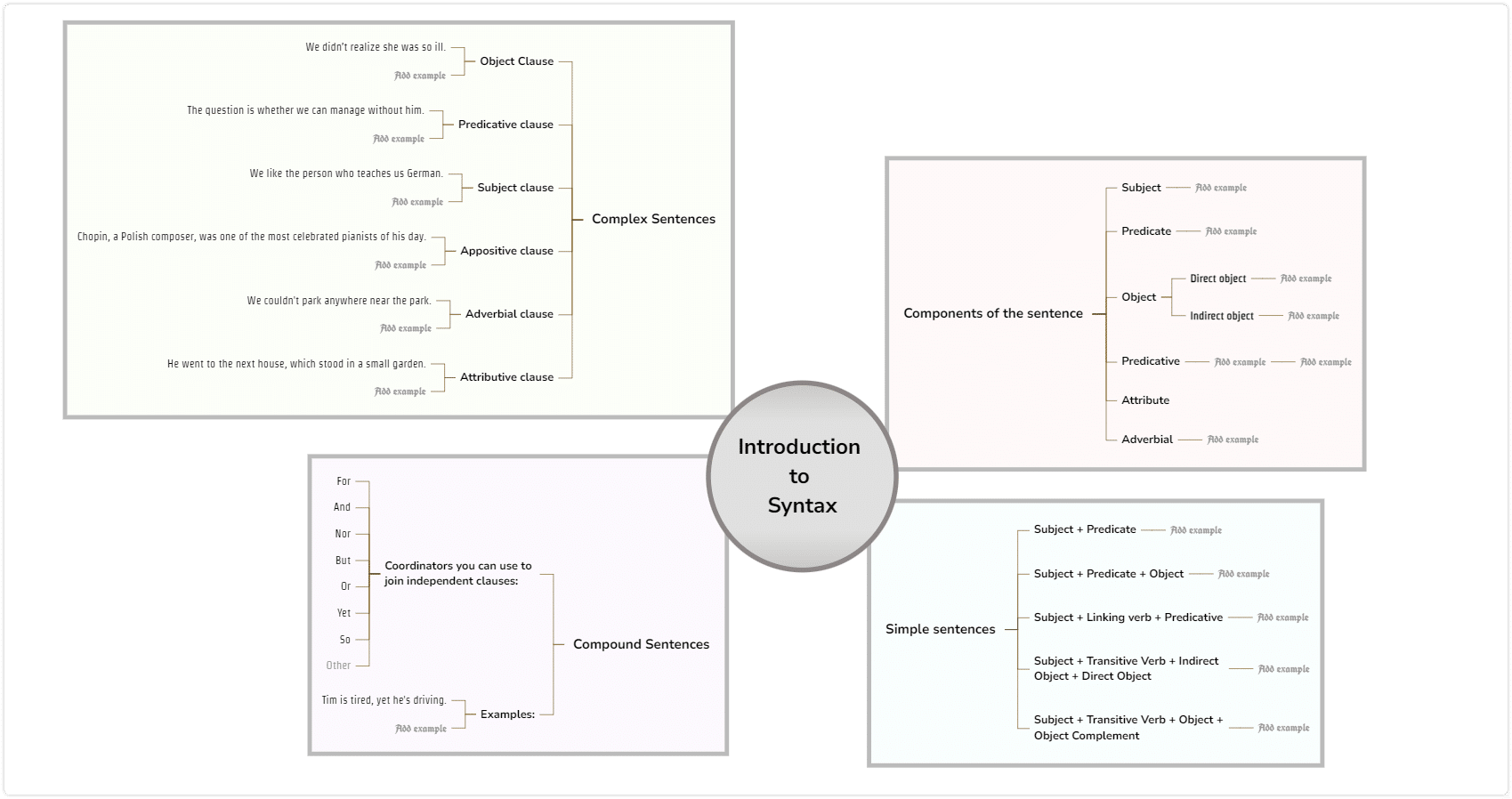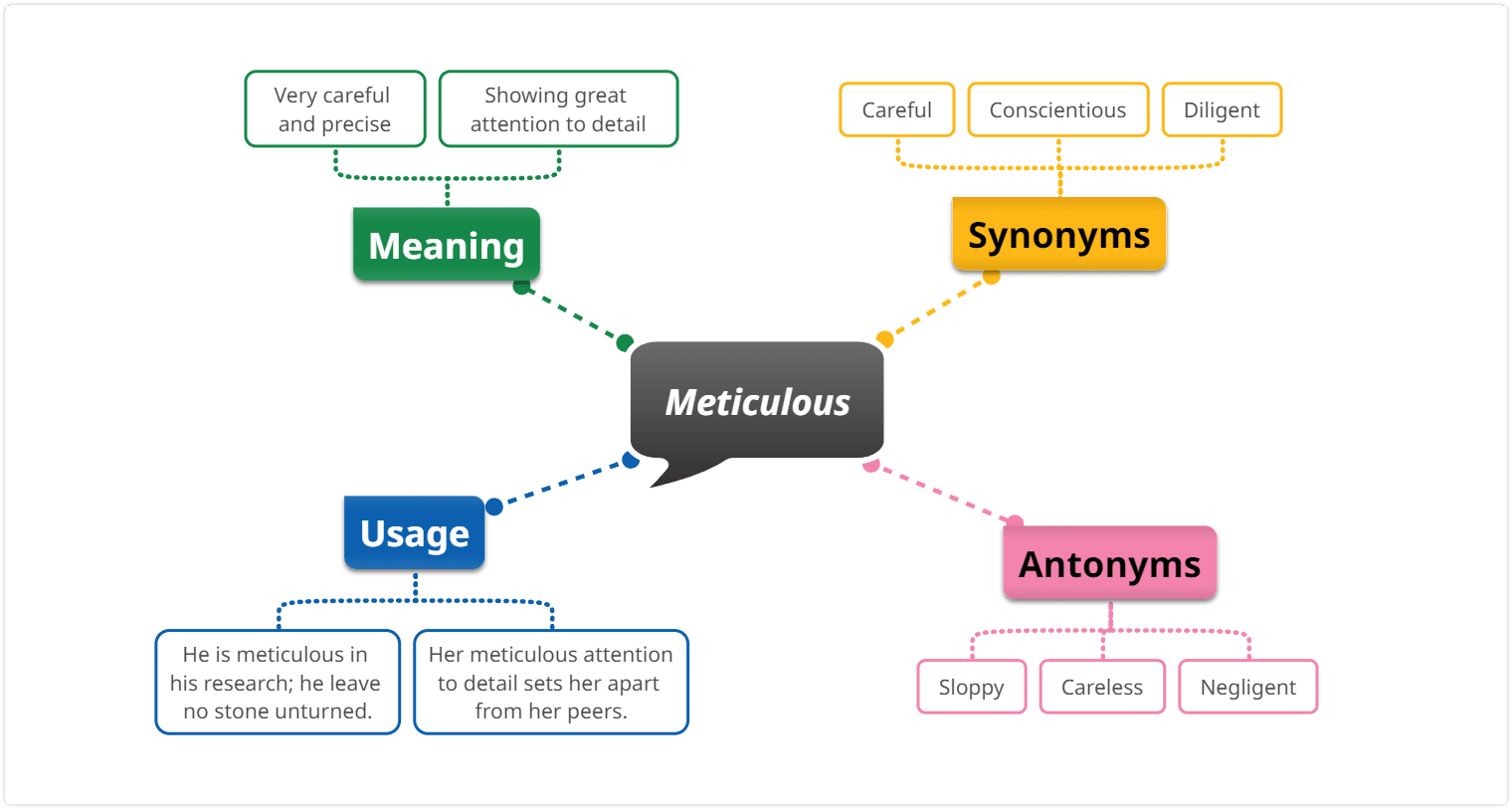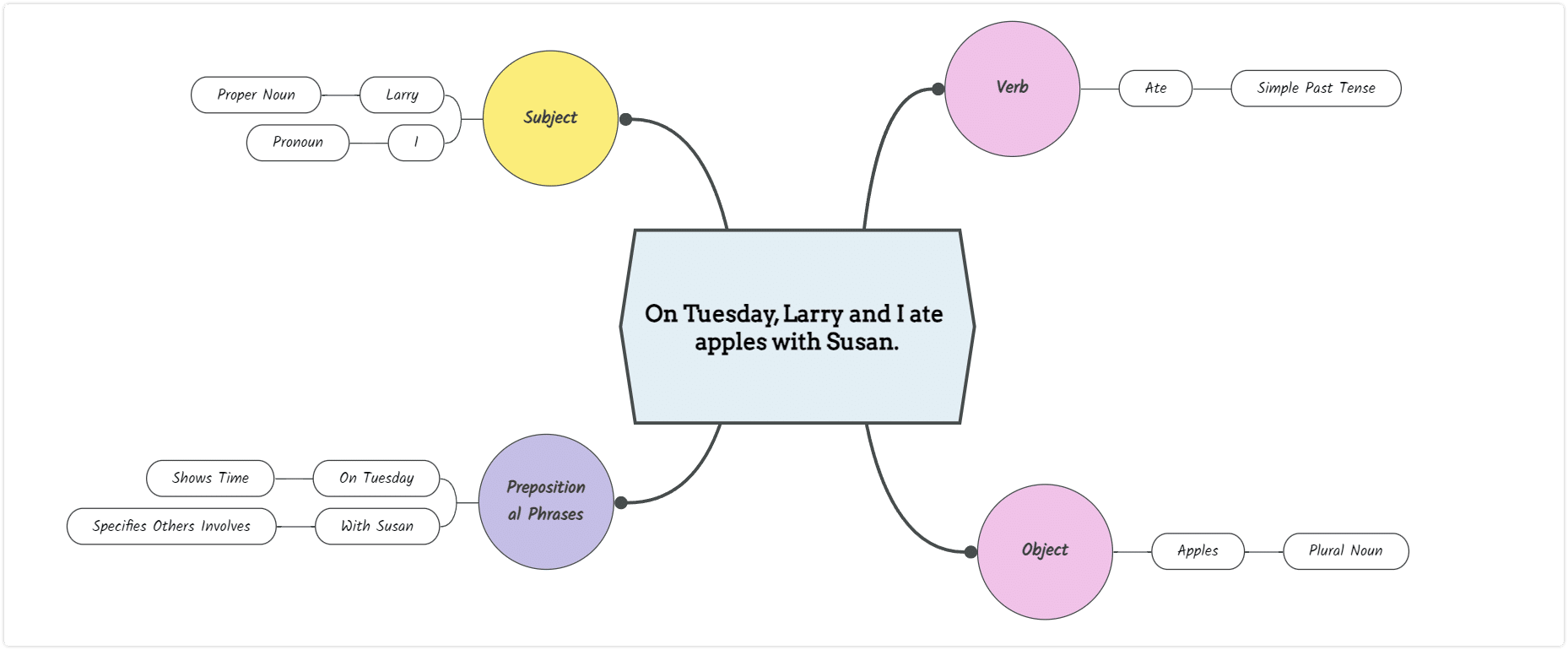
Unraveling the Power of Mind Maps for English Fluency
The importance of English fluency in today’s global landscape cannot be overstated. As we navigate an increasingly interconnected world, mastering the English language has become a fundamental requirement for many. But how do we move beyond the basics to reach a level of comfort and ease?
Enter mind maps, one of a number of incredible learning hacks.
This creative thinking tool is a go-to technique for teachers and students alike. The central concept is a visual representation of information that organizes ideas around a central topic.
But how do teachers use mind maps, and how do you make a mind map for a lesson?
Let’s demystify these questions.
Understanding the Role of a Mind Map in English Lessons
Decoding the Science of Mind Maps
Mind mapping, a process developed by Tony Buzan, begins with a central idea or topic. This central concept serves as the foundation for the rest of the mind map. It’s like the seed from which the rest of your map — your thoughts and ideas — will grow.
The Power of Organization
From the main new idea, branches are created. These branches are effectively subtopics or categories related to the central one. They can extend outward, much like the branches of a tree.
Each branch forms a part of the whole story that the mind map intends to tell. To illustrate, if you’re using a mind map to study the English language, your main idea might be ‘American vs. British English’. The branches extending from this could be ‘Grammar’, ‘Vocabulary’, and so forth.
Mindomo has a great template for brainstorming just this topic that you can explore right now. This is just one of many mind map examples on Mindomo.

But the science of mind mapping doesn’t stop at the first layer of branches. Further sub-branches can be created that dig deeper into the subtopics. Maybe you’d like to do a deep dive on ‘English Tenses’ for example. In that case, you’d have subtopics like past, present, and future tenses.
Each of these could be further divided into the different kinds of tenses that fall under each broad category. This hierarchical structure allows for detailed exploration of a concept, breaking down complex information into easily digestible chunks.

The Power of the Visual
The real power of mind maps, however, lies in their visual nature. Mind maps are a form of data visualization. (read more about what is data visualization) They allow the brain to see and understand relationships between different pieces of information. For instance, by creating a mind map, you can visualize how word order and syntax affect meaning in a language like English.

Colors, symbols, images, or even doodles can be added for greater impact. They can help you emphasize specific points or trigger memory cues. These visual elements serve a dual purpose.
First, they make the learning process more engaging and fun, helping to maintain interest.
Second, they harness the brain’s ability to process visual information, improving recall and comprehension.
Harnessing Cognitive Benefits of Mind Maps
To understand the cognitive benefits of mind maps, it’s essential to appreciate the fundamental ways in which our brains process information. Human cognition is inherently visual. We comprehend and remember visual information far more effectively than plain text, as images allow us to perceive and recall a vast array of data at a glance.
The brain naturally associates images, shapes, and colors, creating neural pathways that boost memory and recall.
Therefore, when we use mind maps in learning, we are essentially tapping into these natural cognitive processes.
Organize Your Ideas Naturally
By visually structuring words, phrases, and concepts in a network of interconnected branches, we create a mental ‘map.’ This map mirrors our internal thought processes. Each branch in a mind map can trigger an entire series of related ideas. This makes it easy to explore different concepts and boosts the development of new ideas.
The Power of Colors and Shapes for Understanding and Recall
Moreover, colors and images incorporated in a mind map can serve as mnemonic devices, aiding memory and recall. For instance, when learning English vocabulary using a mind map, associating a word with a particular image or color can trigger the memory of that word and its meaning. This makes the recall process more efficient, helping us to grasp new vocabulary more quickly and easily.
In addition to enhancing memory and recall, mind maps also promote creativity and critical understanding. The process of creating a mind map involves an element of creativity – choosing where to place ideas, how to branch off sub-topics, and what colors or images to use. This creative activity stimulates the brain, keeping it engaged and making the learning process more enjoyable.
Yes, Space Does Matter
Furthermore, the spatial arrangement of ideas in a mind map can help in understanding complex subjects or problems. By visually displaying the hierarchical relationships between concepts and sub-concepts, mind maps help us see the ‘big picture’. This holistic perspective aids in better understanding and problem-solving.
In summary, mind maps leverage our natural cognitive abilities for visual processing and creative thinking. This makes learning a more engaging and effective process.
Mind Maps: A Gateway to Accelerated Language Acquisition
Language learning is, in essence, a complex task that requires mastery of numerous components. It involves grammar rules, vocabulary, pronunciation, sentence structures, and more.
Traditional learning methods often approach these components linearly, focusing on one aspect at a time, which can be overwhelming. And it can be boring.
Enter mind maps. With mind map English lessons, the process of how to learn a new language can be revolutionized.
Mind Maps & Different Types of Vocabulary
To begin with, mind maps significantly aid in improving reading skills. When reading in a foreign language, it’s common to come across new words or phrases. Instead of simply noting them down linearly, you could create a mind map.
The central topic could be the new word, with branches representing its meaning, synonyms, antonyms, or sentences where it could be used. This process helps in gaining a comprehensive understanding of the word and its usage, thereby enhancing reading comprehension.

Next, mind maps can be instrumental in vocabulary expansion. A well-structured mind map can help you categorize vocabulary based on various factors like their meaning, context, or part of speech. You can even create branches for the etymology or the origin of words.
This approach not only aids in memorizing vocabulary but also in understanding its appropriate usage. Additionally, by visually associating words with images or colors in your mind map, you can leverage your brain’s natural inclination towards visual data, making recall easier.
Mind Maps & Grammar
Understanding grammar, a vital part of language learning, can also be facilitated with mind maps. Grammar rules often seem complicated due to their intricate structure and numerous exceptions. By using a mind map, these rules can be broken down into smaller, manageable parts.
For instance, if you’re learning English tenses, the central idea of your mind map could be ‘English Tenses’, with branches for ‘Past’, ‘Present’, and ‘Future’. Each of these could further branch out to ‘Simple’, ‘Continuous’, ‘Perfect’, and ‘Perfect Continuous’ tenses, providing a clear, visual representation of how different tenses work.
Lastly, mind maps can also help with understanding and remembering sentence structures. By breaking down complex sentences into simple components and visually demonstrating the relationship between them, learners can improve.
They’ll end up with a better grasp of how different parts of a sentence come together, so they can write and communicate with more clarity.
A Step-by-Step Guide to Using Mind Maps for English Fluency
Crafting a Learning Mind Map: Start with a Central Idea
Wondering how to mind map? Start by writing the central topic or word in the middle of a piece of paper or a digital tool.
Draw branches from the center to represent the main ideas or themes. Add further sub-branches for more specific details.
Tip: Use colors, images, and symbols for better memorization and understanding. This process helps your brain to organize ideas and remember them more effectively.
Mind Maps for Vocabulary Expansion: An Effective Approach
Take a word or phrase from your learning journey and place it in the center of your map. Think about related words or phrases, and start creating branches. This method helps to embed new vocabulary into your memory by contextualizing it within a broader network of related terms.
Simplifying Grammar Rules with Mind Maps
Mind maps can help explain the complex structures and rules that characterize the English language. Use a mind map to break down grammar rules into understandable segments. This creates a fun and engaging way to learn English grammar, as opposed to rote memorization.
Mind Maps: Your Ally in Perfecting English Pronunciation
Pronunciation can be a significant barrier to becoming fluent in English. Mind maps can help you note down and visualize phonetic spellings and stress patterns, helping you to improve your pronunciation skills.
Mastering English Sentence Structures with Mind Maps
Place a simple sentence in the middle of your mind map. On the branches, explore different ways to expand the sentence or make it more complex. This technique helps you understand sentence structures better.

Enhancing Listening Skills: The Mind Map Way
While listening to an English audio lesson or a conversation, note down the main ideas and details in a mind map. This will not only improve your listening skills but also help you understand the structure of English conversations.
Pro Tips for Successful Mind Mapping for English Fluency
1. Starting Your Mind Mapping Journey: First Steps
Start simple. Don’t worry about creating the ‘perfect’ mind map. The most important thing is to begin.
Use sticky notes, different colored pens, or diagram software – whatever works best for you. Experiment with different methods and adapt the process to suit your learning style.
2. Secrets of Effective Mind Mapping: Techniques to Master
Use single words or simple phrases for each idea. Draw images to represent ideas – this leverages your brain’s capacity for visual thinking. Connect related concepts with lines or arrows to show relationships.
3. Stay Consistent, Stay Motivated: The Recipe for Success
Like any learning technique, consistency is key. Make mind mapping a regular part of your study routine. It’s a great way to review your learning and discover areas that need more focus.
4. Leverage the Power of Technology: Try Mind Mapping Software
Mind mapping software like Mindomo can help you solve countless complex problems. It gives you the power to streamline your learning process. It allows you to create visuals for presentations and more. And it can even allow you to work with others via a simple, intuitive collaboration feature.
And since Mindomo features several powerful templates geared for English language learners, it’s incredibly easy to get started.
Conclusion: The Mind Map Path to English Fluency
From boosting vocabulary to simplifying grammar rules, mind maps serve as a comprehensive tool for English learning. They provide a structured yet flexible way to grasp the complexities of the English language. But this is only one subject where mind maps can help.
Mind maps can also help with taking notes, brainstorming ideas, and even developing an outline.
So, whether you’re a student or an aspiring English learner seeking new techniques, the mind map can be your roadmap to success. Embrace the power of mind mapping, and watch your English fluency soar. Happy mapping!
Keep it smart, simple, and creative!
The Mindomo Team






